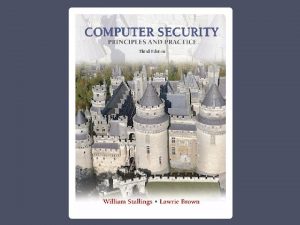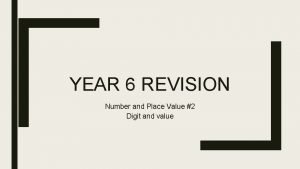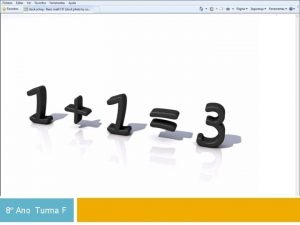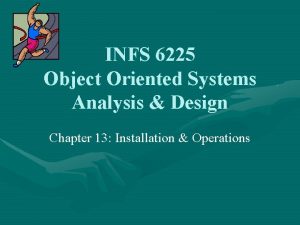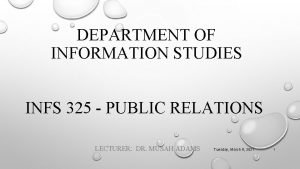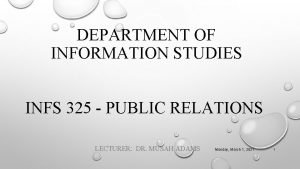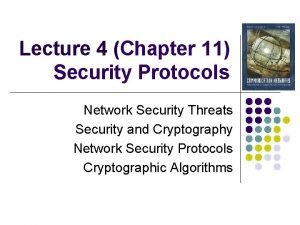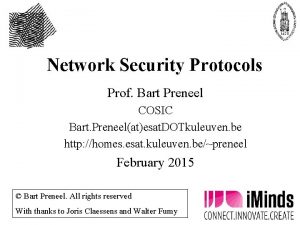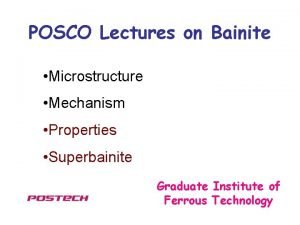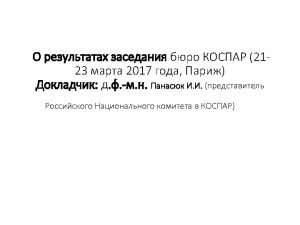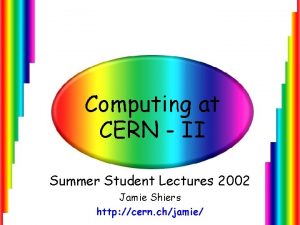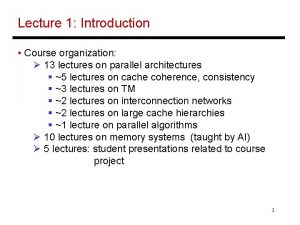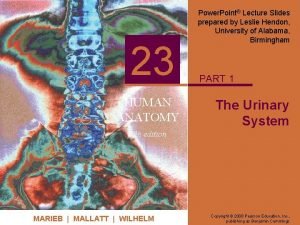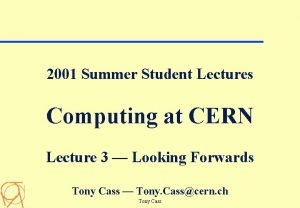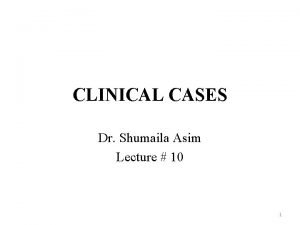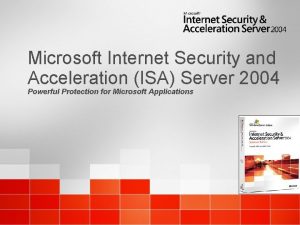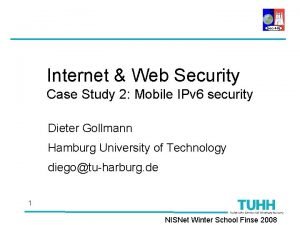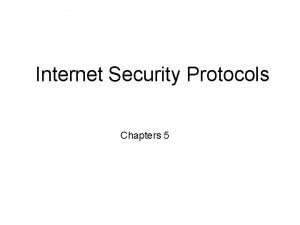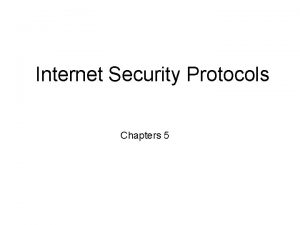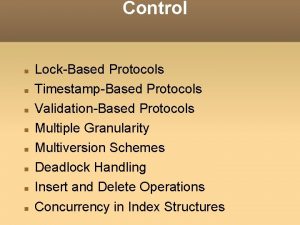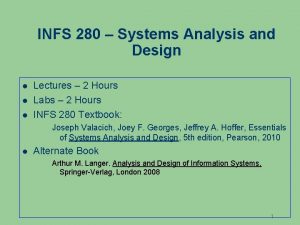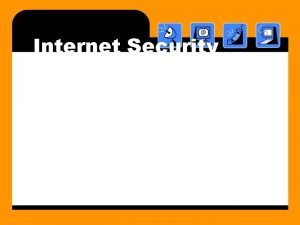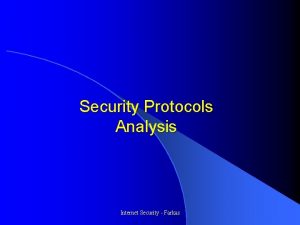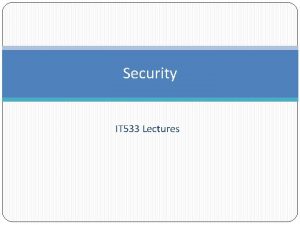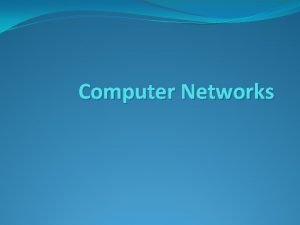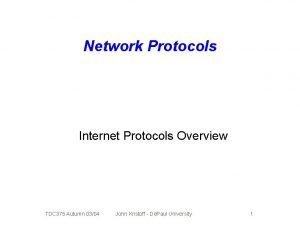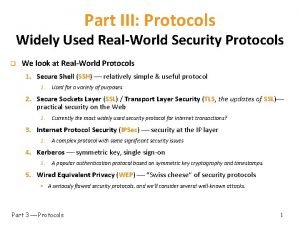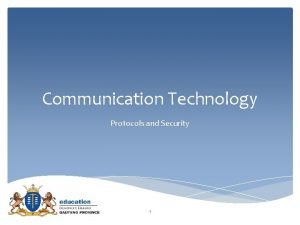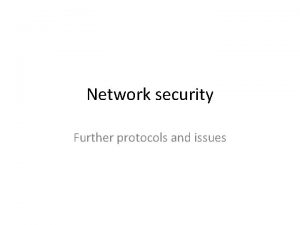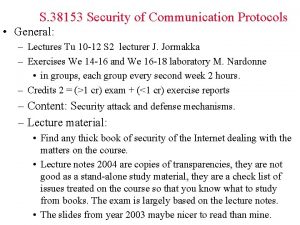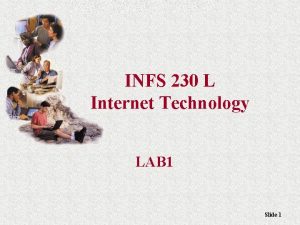INFS 766INFT 865 Internet Security Protocols Lectures 3












































































- Slides: 76

INFS 766/INFT 865 Internet Security Protocols Lectures 3 and 4 Cryptography in network protocols Prof. Ravi Sandhu

CRYPTOGRAPHY

CRYPTOGRAPHIC TECHNOLOGY SECRET KEY PUBLIC KEY Symmetric Key Single Key Conventional Asymmetric Key Two Key © Ravi Sandhu 2000 3

CRYPTOGRAPHIC TECHNOLOGY u Secret-key encryption u Public-key digital signatures u Public-key agreement u Message digests u Message authentication codes u Challenge-response authentication u Public-key certificates © Ravi Sandhu 2000 4

CRYPTOGRAPHIC SERVICES u confidentiality l traffic flow confidentiality u integrity u authentication u non-repudiation © Ravi Sandhu 2000 5

SECRET KEY CRYPTOSYSTEM INSECURE CHANNEL Plaintext Ciphertext Encryption Algorithm E Decryption Algorithm D A Secret Key shared by A and B © Ravi Sandhu 2000 Plaintext B K K SECURE CHANNEL 6

SECRET KEY CRYPTOSYSTEM u confidentiality depends only on secrecy of the key l size of key is critical u secret l u. A key systems do not scale well with N parties we need to generate and distribute N*(N-1)/2 keys and B can be people or computers © Ravi Sandhu 2000 7

MASTER KEYS AND SESSION KEYS u long-term l prolonged use increases exposure u session l or master keys short-term keys communicated by means of n long-term secret keys n public key technology © Ravi Sandhu 2000 8

CRYPTANALYSIS u ciphertext l cryptanalyst only knows ciphertext u known l only plaintext cryptanalyst knows some plaintextciphertext pairs u chosen plaintext u chosen ciphertext © Ravi Sandhu 2000 9

KNOWN PLAINTEXT ATTACK bit key requires 239 5 * 1011 trials on average (exportable from USA) u trials/second time required 1 20, 000 years 103 20 years 106 6 days 109 9 minutes 1012 0. 5 seconds u 40 © Ravi Sandhu 2000 10

KNOWN PLAINTEXT ATTACK bit key requires 255 3. 6 * 10^16 trials on average (DES) u trials/second time required 1 109 years 103 106 years 106 103 years 109 1 year 1012 10 hours u 56 © Ravi Sandhu 2000 11

KNOWN PLAINTEXT ATTACK bit key requires 279 6 * 1023 trials on average (SKIPJACK) u trials/second time required 1 1016 years 103 1013 years 106 1010 years 109 107 years 1012 104 years u 80 © Ravi Sandhu 2000 12

KNOWN PLAINTEXT ATTACK bit key requires 2127 2 * 1038 trials on average (IDEA) u trials/second time required 1 1030 years 103 1027 years 106 1024 years 109 1021 years 1012 1018 years u 128 © Ravi Sandhu 2000 13

DICTIONARY ATTACKS u if keys are poorly chosen known plaintext attacks can be very simple u often the user’s password is the key in a dictionary attack the cryptanalyst tries passwords from a dictionary, rather than all possible keys l for a 20, 000 word dictionary, 1 trial/second will crack a poor password in less than 3 hours l © Ravi Sandhu 2000 14

CURRENT GENERATION SECRET KEY CRYPTOSYSTEMS u 64 l l l l bit data block size DES: 56 bit key Triple DES: 112 bit key Triple DES: 168 bit key Skipjack: 80 bit key IDEA: 128 bit key RC 2: variable size key: 1 byte to 128 bytes many others © Ravi Sandhu 2000 15

DOUBLE DES Intermediate Ciphertext Plaintext l Ciphertext E E K 1 K 2 effective key size is only 57 bits due to meet-inthe-middle attack © Ravi Sandhu 2000 16

TRIPLE DES Ciphertext Plaintext l E D E K 1 K 2 K 1 effective key size is 112 bits due to meet-in-themiddle attack © Ravi Sandhu 2000 17

PERFECT SECRECY VERNAM ONE-TIME PAD Ciphertext Plaintext Mi Secret Key + Ki Ci Plaintext + Ki SECURE CHANNEL © Ravi Sandhu 2000 Mi A B 00 0 01 1 10 1 11 0 18

PERFECT SECRECY VERNAM ONE-TIME PAD u known plaintext reveals the portion of the key that has been used, but does not reveal anything about the future bits of the key u has been used u can be approximated © Ravi Sandhu 2000 19

NEXT GENERATION SECRET KEY CRYPTOSYSTEMS u new Advanced Encryption Standard under development by NIST l must support key-block combinations of 128 -128, 192 -128, 256 -128 l may support other combinations u ongoing international competition u will be in place in a couple of years © Ravi Sandhu 2000 20

ELECTRONIC CODE BOOK (ECB) MODE 64 bit Data block 56 bit key D E 64 bit Data block u u OK for small messages identical data blocks will be identically encrypted © Ravi Sandhu 2000 21

CIPHER BLOCK CHAINING (CBC) MODE 64 bit Data block + 64 bit previous ciphertext block 56 bit key D E is the exclusive OR operation © Ravi Sandhu 2000 64 bit previous ciphertext block 64 bit Data block + 22

CIPHER BLOCK CHAINING (CBC) MODE u Needs an Initialization Vector (IV) to serve as the first feedback block u IV need not be secret or random u Integrity of the IV is important, otherwise first data block can be arbitrarily changed. u IV should be changed from message to message, or first block of every message should be distinct © Ravi Sandhu 2000 23

PUBLIC KEY ENCRYPTION INSECURE CHANNEL Plaintext Ciphertext Encryption Algorithm E Decryption Algorithm D A B B's Public Key © Ravi Sandhu 2000 Plaintext B's Private Key RELIABLE CHANNEL 24

PUBLIC KEY CRYPTOSYSTEM u solves the key distribution problem provided there is a reliable channel for communication of public keys u requires reliable dissemination of 1 public key/party u scales well for large-scale systems © Ravi Sandhu 2000 25

PUBLIC KEY ENCRYPTION u confidentiality based on infeasibility of computing B's private key from B's public key u key sizes are large (512 bits and above) to make this computation infeasible © Ravi Sandhu 2000 26

SPEED OF PUBLIC KEY VERSUS SECRET KEY u Public l key runs at kilobits/second think modem connection u Secret key runs at megabits/second and even gigabits/second l think LAN or disk connection u This large difference in speed is likely to remain independent of technology advances © Ravi Sandhu 2000 27

RSA u public key is (n, e) u private key is d u encrypt: C = Me mod n u decrypt: M = Cd mod n © Ravi Sandhu 2000 28

GENERATION OF RSA KEYS u choose 2 large (100 digit) prime numbers p and q u compute n = p * q u pick e relatively prime to (p-1)*(q-1) u compute d, e*d = 1 mod (p-1)*(q-1) u publish (n, e) u keep d secret (and discard p, q) © Ravi Sandhu 2000 29

PROTECTION OF RSA KEYS u compute l d, e*d = 1 mod (p-1)*(q-1) if factorization of n into p*q is known, this is easy to do u security of RSA is no better than the difficulty of factoring n into p, q © Ravi Sandhu 2000 30

RSA KEY SIZE u key size of RSA is selected by the user casual l “commercial” l “military” l © Ravi Sandhu 2000 384 bits 512 bits 1024 bits 31

DIGITAL SIGNATURES INSECURE CHANNEL Plaintext + Signature Algorithm S Verification Algorithm V A B A's Private Key © Ravi Sandhu 2000 Yes/No A's Public Key RELIABLE CHANNEL 32

COMPARE PUBLIC KEY ENCRYPTION INSECURE CHANNEL Plaintext Ciphertext Encryption Algorithm E Decryption Algorithm D A B B's Public Key © Ravi Sandhu 2000 Plaintext B's Private Key RELIABLE CHANNEL 33

DIGITAL SIGNATURES IN RSA u RSA has a unique property, not shared by other public key systems u Encryption and decryption commute (Me mod n)d mod n = M l (Md mod n)e mod n = M l encryption signature u Same public key can be use for encryption and signature © Ravi Sandhu 2000 34

EL GAMAL AND VARIANTS u encryption only u signature only 1000’s of variants l including NIST’s DSA l © Ravi Sandhu 2000 35

NIST DIGITAL SIGNATURE STANDARD u System-wide p lq lg l 512 -1024 bit prime 160 bit prime divisor of p-1 g = h((p-1)/q) mod p, 1<h<p-1 u El-Gamal l constants variant separate algorithms for digital signature and public-key encryption © Ravi Sandhu 2000 36

NIST DIGITAL SIGNATURE STANDARD u to l l l sign message m: private key x choose random r compute v = (gr mod p) mod q compute s = (m+xv)/k mod q signature is (s, v, m) verify signature: public key y compute u 1 = m/s mod q compute u 2 = v/s mod q verify that v = (gu 1*yu 2 mod p) mod q © Ravi Sandhu 2000 37

NIST DIGITAL SIGNATURE STANDARD u signature does not repeat, since r will be different on each occasion u if same random number r is used for two messages, the system is broken u message expands by a factor of 2 u RSA signatures do repeat, and there is no message expansion © Ravi Sandhu 2000 38

DIFFIE-HELLMAN KEY ESTABLISHMENT A y. A=ax. A mod p public key private key x. A y. B=ax. B mod p public key B private key x. B k = y. Bx. A mod p = y. Ax. B mod p = ax. A*x. B mod p system constants: p: prime number, a: integer © Ravi Sandhu 2000 39

DIFFIE-HELLMAN KEY ESTABLISHMENT u security depends on difficulty of computing x given y=ax mod p called the discrete logarithm problem © Ravi Sandhu 2000 40

CURRENT GENERATION PUBLIC KEY SYSTEMS u RSA (Rivest, Shamir and Adelman) l l u El. Gamal Encryption l l u the only one to provide digital signature and encryption using the same public-private key pair security based on factoring public-key encryption only security based on digital logarithm DSA signatures l l l public-key signature only one of many variants of El. Gamal signature security based on digital logarithm © Ravi Sandhu 2000 41

CURRENT GENERATION PUBLIC KEY SYSTEMS u DH (Diffie-Hellman) l l u secret key agreement only security based on digital logarithm ECC (Elliptic curve cryptography) l l security based on digital logarithm in elliptic curve field uses analogs of n n n El. Gamal encryption DH key agreement DSA digital signature © Ravi Sandhu 2000 42

ELLIPTIC CURVE CRYPTOGRAPHY u mathematics is more complicated than RSA or Diffie-Hellman u elliptic curves have been studied for over one hundred years u computation is done in a group defined by an elliptic curve © Ravi Sandhu 2000 43

ELLIPTIC CURVE CRYPTOGRAPHY u 160 bit ECC public key is claimed to be as secure as 1024 bit RSA or Diffie -Hellman key u good for small hardware implementations such as smart cards © Ravi Sandhu 2000 44

ELLIPTIC CURVE CRYPTOGRAPHY u ECDSA: Elliptic Curve digital signature algorithm based on NIST Digital Signature Standard u ECSVA: Elliptic Curve key agreement algorithm based on Diffie-Hellman u ECES: Elliptic Curve encryption algorithm based on El-Gamal © Ravi Sandhu 2000 45

PKCS STANDARDS u de facto standards initiated by RSA Data Inc. © Ravi Sandhu 2000 46

MESSAGE DIGEST original message no limit to size message digest algorithm easy © Ravi Sandhu 2000 message digest 128 bit/160 bit hard 47

MESSAGE DIGEST u for performance reasons sign the message digest l not the message l u one way function m=H(M) is easy to compute l M=H-1(m) is hard to compute l © Ravi Sandhu 2000 48

DESIRED CHARACTERISTICS u weak l hash function difficult to find M' such that H(M')=H(M) u given M, m=H(M) try messages at random to find M’ with H(M’)=m l 2 k trials on average, k=64 to be safe © Ravi Sandhu 2000 49

DESIRED CHARACTERISTICS u strong l hash function difficult to find any two M and M' such that H(M')=H(M) u try pairs of messages at random to find M and M’ such that H(M’)=H(M) 2 k/2 trials on average, k=128 to be safe l k=160 is better l © Ravi Sandhu 2000 50

CURRENTT GENERATION MESSAGE DIGEST ALGORITHMS u MD 5 (Message Digest 5) 128 bit message digest l falling out of favor l u SHA (Secure Hash Algorithm) 160 bit message digest l slightly slower than MD 5 but more secure l © Ravi Sandhu 2000 51

MESSAGE AUTHENTICATION CODES INSECURE CHANNEL Plaintext + Signature Algorithm S Yes/No Verification Algorithm V A B K K Signature = MD of plaintext + K © Ravi Sandhu 2000 52

CURRENT GENERATION MAC ALGORITHMS u HMAC-MD 5, l l HMAC-SHA IETF standard general technique for constructing a MAC from a message digest algorithm u Older MACs are based on secret key encryption algorithms (notably DES) and are still in use l DES based MACs are 64 bit and not considered strong anymore © Ravi Sandhu 2000 53

HMAC u HMAC computation u HMACK(M) = h(K opad || h(K ipad || M) ) l h is any message digest function l M message l K secret key l opad, ipad: fixed outer and inner padding u HMAC-MD 5, © Ravi Sandhu 2000 HMAC-SHA 54

SAFE CRYPTOGRAPHY u Secret-key l encryption 128 bit or higher u Public-key l 1024 bit or higher u Message l digests 160 bit or higher u. A large portion of what is deployed is much weaker © Ravi Sandhu 2000 55

STRONG AUTHENTICATION CHALLENGE RESPONSE NETWORK STATION HOST User ID Challenge Response © Ravi Sandhu 2000 56

CHALLENGE RESPONSE Secret Key Challenge Encrypt Response © Ravi Sandhu 2000 57

CHALLENGE RESPONSE Secret Key Challenge HMAC Response © Ravi Sandhu 2000 58

TIME SYNCHRONIZED NETWORK STATION HOST User ID One Time Password © Ravi Sandhu 2000 59

TIME SYNCHRONIZED Secret Key Time HMAC One Time Password © Ravi Sandhu 2000 60

PUBLIC KEY BASED Private Key Challenge Sign Response=signed(challenge) © Ravi Sandhu 2000 61

PUBLIC KEY BASED Private Key Time Sign Response=signed(Time) © Ravi Sandhu 2000 62

PUBLIC-KEY INFRASTRUCTURE

PUBLIC-KEY CERTIFICATES u reliable distribution of public-keys u public-key encryption l sender needs public key of receiver u public-key l receiver needs public key of sender u public-key l digital signatures key agreement both need each other’s public keys © Ravi Sandhu 2000 64

X. 509 CERTIFICATE VERSION SERIAL NUMBER SIGNATURE ALGORITHM ISSUER VALIDITY SUBJECT PUBLIC KEY INFO SIGNATURE © Ravi Sandhu 2000 65

X. 509 CERTIFICATE 1 1234567891011121314 RSA+MD 5, 512 C=US, S=VA, O=GMU, OU=ISSE 9/9/99 -1/1/1 C=US, S=VA, O=GMU, OU=ISSE, CN=Ravi Sandhu RSA, 1024, xxxxxxxxxxxxx SIGNATURE © Ravi Sandhu 2000 66

CERTIFICATE TRUST u how to acquire public key of the issuer to verify signature u whether or not to trust certificates signed by the issuer for this subject © Ravi Sandhu 2000 67

PEM CERTIFICATION GRAPH Internet Policy Registration Authority IPRA Policy Certification Authorities (PCAs) HIGH ASSURANCE MITRE MID-LEVEL ASSURANCE Certification Authorities (CAs) Abrams RESIDENTIAL PERSONA GMU Virginia Anonymous ISSE Fairfax LEO Sandhu Subjects © Ravi Sandhu 2000 68

CRL FORMAT SIGNATURE ALGORITHM ISSUER LAST UPDATE NEXT UPDATE REVOKED CERTIFICATES SIGNATURE SERIAL NUMBER REVOCATION DATE © Ravi Sandhu 2000 69

X. 509 CERTIFICATES u X. 509 v 1 l very basic u X. 509 v 2 l adds unique identifiers to prevent against reuse of X. 500 names u X. 509 v 3 adds many extensions l can be further extended l © Ravi Sandhu 2000 70

X. 509 v 3 CERTIFICATE INNOVATIONS u distinguish various certificates l u identification info in addition to X. 500 name l u u good enough for casual email but not for signing checks limits on use of signature keys for further certification extensible l u internet names: email addresses, host names, URLs issuer can state policy and usage l u signature, encryption, key-agreement proprietary extensions can be defined and registered attribute certificates l ongoing work © Ravi Sandhu 2000 71

X. 509 v 2 CRL INNOVATIONS u CRL distribution points u indirect CRLs u delta CRLs u revocation reason u push CRLs © Ravi Sandhu 2000 72

GENERAL HIERARCHICAL STRUCTURE Z X Y Q A a R C b c © Ravi Sandhu 2000 S E d e G f g T I h i K j k M l m O n o p 73

GENERAL HIERARCHICAL STRUCTURE WITH ADDED LINKS Z X Y Q A a R C b c © Ravi Sandhu 2000 S E d e G f g T I h i K j k M l m O n o p 74

TOP-DOWN HIERARCHICAL STRUCTURE Z X Y Q A a R C b c © Ravi Sandhu 2000 S E d e G f g T I h i K j k M l m O n o p 75

FOREST OF HIERARCHIES © Ravi Sandhu 2000 76
 Heartbeat alert chapter 22
Heartbeat alert chapter 22 Place value of 865
Place value of 865 Notação cientifica de 865 000
Notação cientifica de 865 000 Infs 2022
Infs 2022 Infs 325
Infs 325 Infs sponsorship code
Infs sponsorship code Semdr communication model
Semdr communication model Infs 325
Infs 325 Provate security
Provate security Network security protocols
Network security protocols Network security protocols
Network security protocols Utilities and energy lectures
Utilities and energy lectures Pab ankle fracture
Pab ankle fracture Bhadeshia lectures
Bhadeshia lectures Bureau of lectures
Bureau of lectures Reinforcement learning lectures
Reinforcement learning lectures Data mining lectures
Data mining lectures Hegel three forms of art
Hegel three forms of art Frcr physics lectures
Frcr physics lectures Cell and molecular biology lectures
Cell and molecular biology lectures Cern summer student lectures
Cern summer student lectures Medical emergency student lectures
Medical emergency student lectures Oral communication 3 lectures text
Oral communication 3 lectures text Translation 1
Translation 1 Tamara berg husband
Tamara berg husband Introduction to web engineering
Introduction to web engineering Yelena bogdan md
Yelena bogdan md Orthopedic ppt lectures
Orthopedic ppt lectures 13 lectures
13 lectures Trend lectures
Trend lectures Advanced medicinal chemistry
Advanced medicinal chemistry Nuclear medicine lectures
Nuclear medicine lectures Introduction to recursion
Introduction to recursion Radio astronomy lectures
Radio astronomy lectures Pathology lectures for medical students
Pathology lectures for medical students Anatomy lectures powerpoint
Anatomy lectures powerpoint Medical hematology student lectures
Medical hematology student lectures C programming lectures
C programming lectures Rick trebino lectures
Rick trebino lectures Digital logic design lectures
Digital logic design lectures Do words have power
Do words have power Comsats virtual campus lectures
Comsats virtual campus lectures Cs614 short lectures
Cs614 short lectures Reinforcement learning lectures
Reinforcement learning lectures Theory of translation lectures
Theory of translation lectures Cs106b
Cs106b Guyton physiology lectures
Guyton physiology lectures Power system lectures
Power system lectures Cern summer school lectures
Cern summer school lectures Dr sohail lectures
Dr sohail lectures Dr asim lectures
Dr asim lectures Rcog eportfolio
Rcog eportfolio Haematology lectures
Haematology lectures Lectures paediatrics
Lectures paediatrics Jim kurose gaia
Jim kurose gaia Frcr physics lectures
Frcr physics lectures Activity based approach in software project management
Activity based approach in software project management Hugh blair lectures on rhetoric
Hugh blair lectures on rhetoric Bba lectures
Bba lectures Cdeep lectures
Cdeep lectures What is aerodynamics
What is aerodynamics Theory and practice of translation lectures
Theory and practice of translation lectures What is internet
What is internet Angel binary internet security
Angel binary internet security Security architecture for the internet protocol
Security architecture for the internet protocol Iss internet security scanner
Iss internet security scanner Internet security and acceleration server
Internet security and acceleration server Internet security case study
Internet security case study Internet explorer 7 security
Internet explorer 7 security Cujo ai smart internet security firewall
Cujo ai smart internet security firewall Integrity in e commerce
Integrity in e commerce Visa international security model
Visa international security model Osi security architecture
Osi security architecture Building security software
Building security software Electronic mail security in network security
Electronic mail security in network security Guide to network security
Guide to network security Security guide to network security fundamentals
Security guide to network security fundamentals
